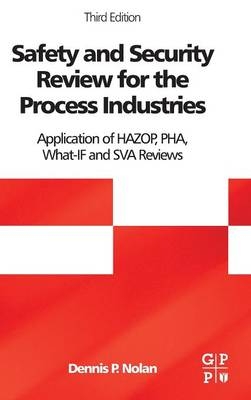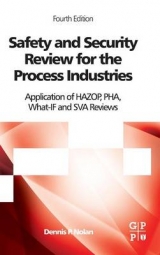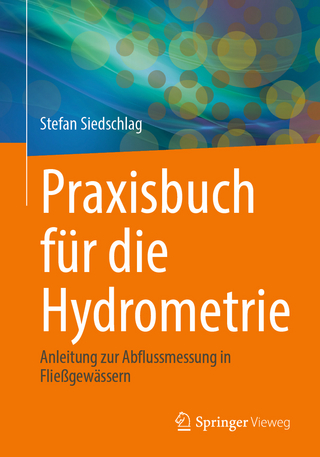
Safety and Security Review for the Process Industries
William Andrew Publishing (Verlag)
978-1-4377-3518-5 (ISBN)
- Titel erscheint in neuer Auflage
- Artikel merken
Safety and Security Review for the Process Industries: Application of HAZOP, PHA, What-IF and SVA Reviews, Third Edition, describes the responsibilities, methods, and documentation required for the performance of qualitative hazard analysis for industrial and commercial processes, specifically Preliminary Hazard Analysis (PHA), What-If, and Hazard and Operability (HAZOP) reviews. It is a guideline and reference book that explains how the methodology and procedures used for these reviews can be adopted and applied for Security Vulnerability Analysis (SVA) to avoid the major risks that have the potential to severely impact the industry. Organized into 13 chapters, the book relies mainly on practices commonly observed in the petroleum, chemical, and petrochemical industries. It begins with an overview of PHA, What-If, and HAZOP reviews, including their limitations and advantages. It then moves into a discussion of safety reviews that are increasingly used in the process industries: Bow-Tie Analysis (BTA), Layers of Protection Analysis (LOPA), and Safety Integrity Level (SIL). The book looks at review team members, their qualifications and responsibilities, and senior management support and responsibilities for the safety and security of a facility. The reader is also introduced to review procedures and worksheets, review applications, preparation and distribution of the study report, and handling and resolution of recommendations. The book concludes by explaining the estimation of review scheduling and cost. This book will serve as a reminder to members of PHA, What-If, and HAZOP review teams about their duties and responsibilities.
Dr. Dennis P. Nolan has had a long career devoted to risk engineering, fire protection engineering, loss prevention engineering and systems safety engineering. He holds a Doctor of Philosophy degree in Business Administration from Berne University, Master of Science degree in Systems Management from Florida Institute of Technology and a Bachelor of Science Degree in Fire Protection Engineering from the University of Maryland. He is a U.S. registered professional engineer in fire protection engineering in the state of California.He is currently on the Executive Management staff of Saudi Aramco, located in Dhahran, Saudi Arabia, as a Loss Prevention Consultant/Chief Fire Prevention Engineer. He covers some of the largest oil and gas facilities in the world. As part of his career, he has examined oil production, refining, and marketing facilities under severe conditions and in various unique worldwide locations, including Africa, Asia, Europe, the Middle East, Russia, and North and South America. His activity in the aerospace field has included engineering support for the NASA Space Shuttle launch facilities at Kennedy Space Center (and for those undertaken at Vandenburg Air Force Base, California) and “classified national defense systems. Dr. Nolan has received numerous safety awards and is a member of the American Society of Safety Engineers, He is the author of many technical papers and professional articles in various international fire safety publications. He has written at least four books, several published by Elsevier.
PrefaceAcknowledgmentsAbout the Author1. Purpose2. Scope3. Objective and Description of PHA, What-If, and HAZOP Reviews 1. Definition 2. Objectives 3. Origins of Qualitative Safety Reviews 4. Limitations or Disadvantages 4.1 Limitations 4.2 Advantages4. Adaptation to Security Vulnerability Analysis 1. Comparison to Process Hazard Analysis Reviews 2. SVA Overall Procedure 3. Major Differences between Security Vulnerability Analyses and Process Hazard Analyses 4. Threat Analysis Necessity5. Specialized Reviews—Bow-Tie Analysis, Layers of Protection Analysis, and Safety Integrity Levels 1. Bow-Tie Analysis 2. Layers of Protection Analysis 3. SIL Analysis6. Team Members, Qualifications, and Responsibilities 1. Team Members 1.1 Minimum team members 1.2 Supplemental members 2. Team Member Qualifications 2.1 Team leader 2.2 Scribe 2.3 Project manager (project, process, manufacturing, or facility engineer) 2.4 Operations representative 2.5 Loss prevention or safety representative 2.6 Security officer or representative (for SVAs) 2.7 Supplemental team member 3. Team Responsibilities 3.1 Team leader 3.2 Scribe 3.3 Project manager (project, process, manufacturing, or facility engineer) 3.4 Operations representative 3.5 Loss prevention or safety representative 3.6 Security officer or representative (for SVAs) 3.7 Supplemental team member(s) 4. Team Dynamics 4.1 Leadership influences 4.2 Lines of communication 4.3 Efficiency factors 5. Use of Consultants 5.1 Qualifications 5.2 Advantages 5.3 Disadvantages 6. Record of Employee Experience7. Management Support and Responsibilities8. Review Applications for Typical Facilities 1. PHA Review Applications 2. What-If Review Applications 3. HAZOP Review Applications 4. SVA Review Applications 5. Application During Changes at a Facility9. Review Procedures 1. Review Preparation and Setup 1.1 Location 1.2 Administrative support 1.3 Facility documentation 1.4 PHA consequence and likelihood data resources 1.5 SVA Threat Analysis data resources 1.6 Computer hardware and software support 1.7 Node identification 1.8 SVA area identification 2. Review Methodology 3. Review Procedure 3.1 Review steps 4. Credible Scenarios and Causes 5. Possible Causes 6. Safeguards 7. Likelihood (Probabilities) 8. Consequences 9. Notetaking 10. Helpful Review Suggestions 11. Helpful Technical Suggestions 11.1 General 11.2 HAZOP suggestions 11.3 General PHA, What-If, HAZOP, and SVA review suggestions 12. Assumptions for the Review Process 13. Providing Recommendations 13.1 Examples of inadequate versus adequate recommendations 13.2 How to rank recommendations 14. Quality Audit10. Review Worksheets 1. PHA Worksheet 2. What-If Worksheet 3. HAZOP Worksheet 4. SVA Worksheets 5. Worksheet Identification11. Report Preparation and Distribution 1. Report Stages and Purpose 2. Report Preparation and Organization 3. Report Distribution 3.1 Preliminary reports 3.2 Draft reports 3.3 Final reports 3.4 Addendum reports12. Handling and Resolution of Recommendations 1. Ranking and Classifying Recommendations 1.1 Recommendation resolution summary 2. Objectives of a Safe and Secure Facility Design 3. Recommendation Action Plans 4. Risk Assessment Studies 5. Risk Acceptance Criteria 6. Cost–Benefit Analysis13. Schedule and Cost Estimates 1. Schedule 1.1 Formula to estimate review scheduling 1.2 Time bar scheduling and integration with project schedule 2. Cost Estimate 3. Estimating Formula 3.1 Cost of preparation 3.2 Cost of review sessions 3.3 Cost of report preparations and review 3.4 Documentation costs 3.5 Hardware, software, and incidental costs 4. Example Calculation for Schedule and CostAppendix A Typical Company Policy StatementAppendix B Quality Assurance Audit ChecklistAppendix C Probability, Severity, Risk, and Risk-Acceptance TablesAppendix D PHA and What-If Checklist QuestionsAppendix E HAZOP Parameters, Deviations, and Possible CausesList of AcronymsGlossaryBibliographyIndex
| Verlagsort | Norwich |
|---|---|
| Sprache | englisch |
| Maße | 152 x 229 mm |
| Gewicht | 350 g |
| Themenwelt | Technik ► Umwelttechnik / Biotechnologie |
| Wirtschaft | |
| ISBN-10 | 1-4377-3518-5 / 1437735185 |
| ISBN-13 | 978-1-4377-3518-5 / 9781437735185 |
| Zustand | Neuware |
| Haben Sie eine Frage zum Produkt? |
aus dem Bereich



